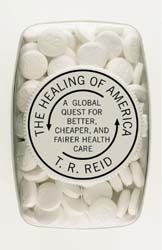
I don’t want our healthcare to be socialized like France’s! (It’s ranked number one in the world.)
If we change our system to be like Canada’s or the Europe’s, then it will be rationed and there won’t be enough! (It’s not rationed by any stretch of the imagination.)
I will lose my doctor if we reform healthcare! (That’s a right-wing/insurance corporation lie made to spread FUD.)
Healthcare coverage is bankrupting the economies of Europe. Besides, healthcare isn’t a right. (Where to begin with this asshole. Healthcare coverage isn’t hurting any of the world’s biggest economies [Germany, UK, France, Canada or Japan] nor is it why the more fragile members are a mess [Spain, Italy, Greece or Portugal]. If you saw how this son of Jabba the Hutt behaved, you would easily blame him for your high premiums.)
How often I have heard these repeated myths, misperceptions and after reading this book, outright lies. Most days I want to slap the crap out of them (the French verb giffler expresses my feeling more accurately) for reflexively regurgitating the talking points of the Republicans, Big Pharma, Big Insurance and the AMA. If this book were thicker, I could use this to hit them upside the head. However, T. R. Reid really didn’t need that many pages to dispel the fog of misinformation on the other developed nations’ systems, which are superior to America’s in quality (most rank higher than America’s), cost (most are under 10% of GDP, the US is 15.3%), effectiveness (hence, those nations have higher life expectancies, lower infant mortality) and here’s the kicker, coverage (the US has 17% of the nation not covered and it’s growing every day; 20,000 Americans die every year from preventable conditions/illnesses too). To be fair, America leads in one category, “responsiveness” which means customer-service matters. Never mind the poor scores on quality (37th), fairness (32nd) and preventative care (37th).
Another impetus for the investigation was the author’s right shoulder. Over 35 years ago he injured it while he was in the Navy. The surgeon fixed it by installing a stainless steel screw into the key joint, an operation known as the Latarjet-Bristow procedure. This worked marvelously for 30 years, allowing him to live a normal life. By the turn of the century, the screw loosened and within a few years Reid experienced pain whenever he moved his right arm doing certain everyday tasks: reaching up on a high shelf, changing a lightbulb, swinging a golf club, etc. Logically, he sees an American orthopedic specialist for a remedy. The (almost) immediate answer from the doctor is a complete shoulder arthroplasty which involves glue, saws and an artificial joint. This operation’s cost is also shrouded in mystery but Reid’s insurance is likely to cover it so he wants to know the risks. The doctor replies calmly: the procedure may fail to alleviate the problem plus there could be paralysis, disease or death.
Reid decides to get second opinions from doctors in the other developed nations (and a couple not-so-developed). Now would be the time thanks to the ongoing battle in America. Before he dedicates a chapter on each country visited, he explains the four major models of healthcare coverage:
- Beveridge: Invented in the UK and followed by Australia, Italy and New Zealand. This is the most commonly misperceived system by Americans because they think all of the EU follows it and there are graves full of Brits caused by it.
- Bismarck: Invented in Germany and practiced by France, Spain, Switzerland and Japan. This one is more ‘capitalistic’ than America’s for-profit systems.
- National Health Insurance: Invented in Canada where it’s called Medicare (the US took the name from them) and Taiwan chose this when they modernized in the Nineties.
- Out of Pocket: When the other three don’t exist, this is what the citizens have and it’s the solution in the underdeveloped-ultra poor nations, China, India and a growing number of Americans.
The United States actually uses versions of all four through (American) Medicare, the VA, the Bureau of Indian Affairs, public employment, private employment, self-employment and those getting the shaft. On the other end of the spectrum, America is the only member of the developed-nation club that allows corporations to make a profit on health insurance (an atrocious 20 cents on every premium dollar is the average). Small wonder why Aetna, UHC, MetLife, etc.; keep cutting out the “unprofitable” with excuses such as “pre-existing conditions” and employ an army of bureaucrats to deny claims.
As for the diagnoses, solutions and coverage Reid received abroad, not one doctor or specialist recommended the shoulder arthroplasty as hastily as their American counterpart. Most said it would be ineffective and unwise but only the UK and Canada would deny him the operation if he wanted it as soon as possible. The UK doctor said his shoulder condition was painful, not life-threatening so physical therapy and treatment would be more effective. Eventually, he could have the surgery in the UK if he pressed and a specialist agreed. Canada’s “denial” was more along the lines of Reid not getting to see the orthopedist. The Canadian doctor had a good assessment (similar to the UK) and explained how long Reid may have to wait. However, contrary to the myth of Canadians “fleeing to America for elective surgery,” a huge majority wait in queue because one thing Reid emphasizes throughout the book, healthcare practices also reflect a nation’s values or mindset. In Canada’s case, Canadians are willing to wait if they know they’re all treated equally, regardless of wealth, ethnicity, etc.
The diagnoses and treatments in India and neighboring Nepal were amusing contrasts. India’s technique using a series of massages, diet, meditation and Yajnopathy (Indian Astrology is the best parallel he could give) did help the author regain more use of the bum shoulder. Nepal was a bust, mostly some weird salve.
Reid concludes the book with facts and dispels the five biggest myths against change. More importantly, he says that before the US calls for the advice of Professor William Hsiao, the healthcare economist other nations seek, America needs to sit down and have a serious talk about who we are, what are our values and where does healthcare fit. While Clinton flopped around in the Nineties, Taiwan and Switzerland had the same argument then. However, they went in the opposite direction and they’re more conservative societies. Why did Clinton get bushwhacked? He approached the problem from the wrong angle, lost control of the debate to the status quo and gave up, especially after he completely transformed into Bush Lite after 1994.
Now there’s a crappy bill to be reconciled by the House and Senate which few are pleased with and will shove the problem down the road for the next decade…if we’re lucky. How did this happen? It was rushed and Americans just lack the patience to approach the problem in a well-thought out manner, especially with the economy in the toilet. Then again, how could anyone get a reasonable word in while being shouted down by astroturf groups like the Teabaggers, Fox News, Palin’s scaremongering, obstinate Republicans and “fiscally conservative” Democrats? Meanwhile, the rest of the developed world will continue to use America’s busted system as the model to avoid whenever they need to tweak their flaws.
